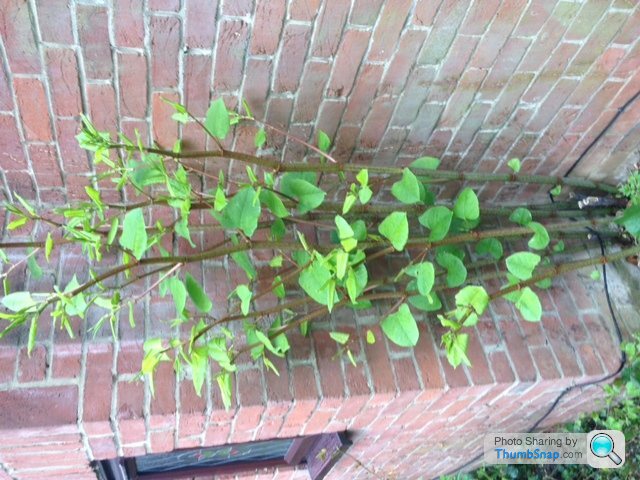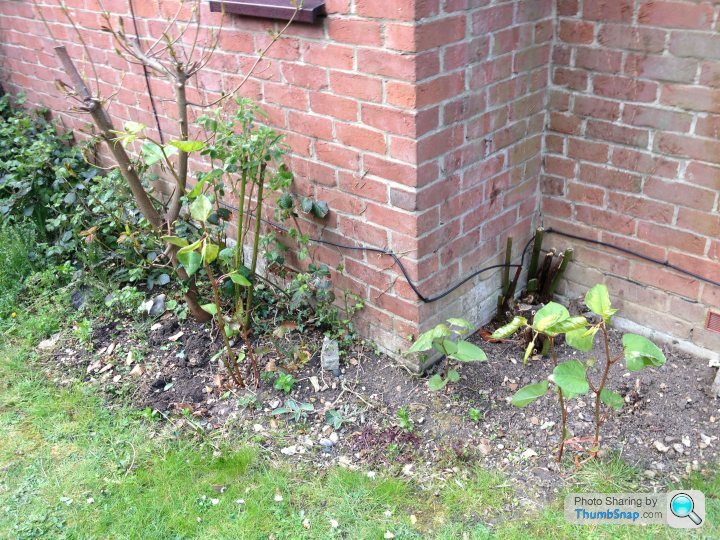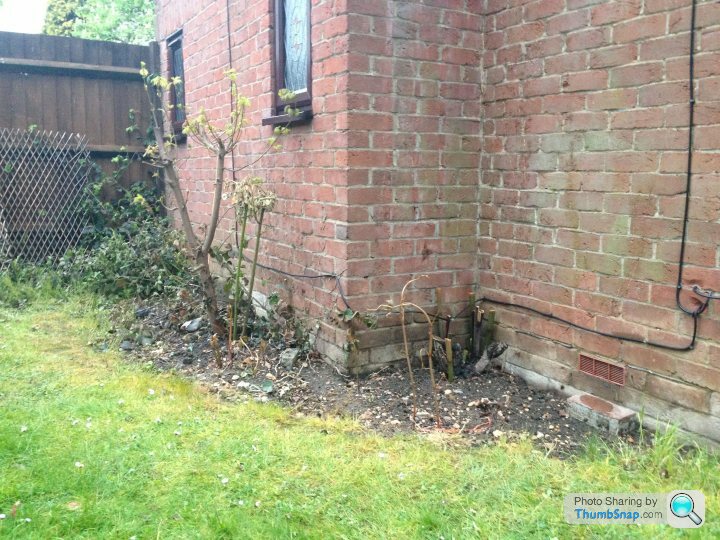knotweed Goddammit!!!!!
Discussion
Just had a tree surgeon around and it looks like we have the dreaded knotweed 
Wasn't picked up by the homebuyer survey and this thing has grown in a little under fortnight...
WTF do we do now. I'm having a building survey next week for possible extension, but as this will bridge over the weed, I'm not sure this is viable anymore...


Wasn't picked up by the homebuyer survey and this thing has grown in a little under fortnight...
WTF do we do now. I'm having a building survey next week for possible extension, but as this will bridge over the weed, I'm not sure this is viable anymore...


Kays vRS said:
I would advise against chopping it down - the stuff will re-grow from the smallest bit of stem/leaf. Treat it as other people have said and wait until it's well and truly dead before getting rid of it. Also check around for other areas of growth as new shoots can grow up to 7 metres away from the main plant.
Hmmm,The plant is right next to the house. 7 metres would place it somewhere under the dining room....
A work colleague suggested a lethal mix of diesel, roundup pro and copper salts.
Kays vRS said:
It will grow through walls, through concrete etc. It might be worth getting in touch with the local council and getting a survey done. In any case I wouldn't leave it much longer before you do something about it as we're into the start of the growing season now.
Damn Now I'm worried
Thanks to everyone for the advice so far. Given there are stumps visible I'm pretty sure tehe former owners of the house concealed the knotweed.
My concern is that once the local authority are alerted , my property becomes worthless. Mortgage lenders refuse point. Blank on properties with knotweed apparently...
My concern is that once the local authority are alerted , my property becomes worthless. Mortgage lenders refuse point. Blank on properties with knotweed apparently...
richyb said:
Having read through most of the posts I thought I'd add in my experience. I've dealt with around 5-6 hectares of J.Knotweed in the last two years and use a variety of methods.
My take on it all - As has been mentioned knotweed can be effectively dealt with without professional help. It is very resilient but has the same weaknesses and requirements. First thing to know is it is feature on wildlife and countryside act 1981. You can not plant or intentionally allow knotweed to grow. To fall foul of this you need to maliciously contaminate someone elses property. Additional rules surrounding it relate more to contractors or public bodies for example burning it or transporting it. It is classified as hazardous waste and as such you need special exemptions or permissions to do so. As a home owner you can burn the stems.
In regards managing knotweed the best approach is via herbicide. This can be applied either by spray (folia application) or by injection. Both have advantages and disadvantages. Spraying is quick but you risk killing everything else around the target, you need a dray day (around 6 hours dry weather after application is ideal), you cannot spray near a watercourse or open drain. Several applications may be needed. Injecting is very effective and will kill the plant very quickly, it is weatherproof and there is very limited risk to surrounding plants. The disadvantage is that it requires some specialist tools (although a syringe can be cautiously used). The best time of year to treat knotweed is once it has gone to flower in late summer. The plant will put most of its energy into this process then will try to recoup before going into dormancy. Herbicide will be most effective then. A method I have seen used but would strongly advise against is cutting the plant at the base then pouring herbicide down the hole. This gives you a cut stem to get rid of and it does not provide the best situation for the herbicide. Most herbicides are systematic meaning they are trans-located around the entire plant before poisoning it. If you cut the stem the plant will not be functioning normally and reduce the effectiveness of the herbicide.
In regards to potential damage it can be very destructive but only when it is left to really establish. I treated a 300 metre section of river and found that the top three runs of brickwork from that length has all been loosened by the root growth. I have also seen large sections of tarmac car parks broken up by the root growth. Only once have I seen anything unusual in a residential setting and that was when some stems has started to come up between the floorboards in someones lounge.
In the OPs case that does appear to be an existing problem. You can see the old dead stems at the base which would be a year old at least.
As mentioned you can DIY it but there are reliable people out there who can assist and for larger stands it would be worth considering. Feel free to Pm me if I can assist.
EDIT- Something to know is that Knotweed seeds are not viable and the plant will not grow from them. It is only spread via suckering and by bits of the root system breaking off.
Thanks for your words of wisdom richyb. I was planning on building an extension exactly where this small stand of weed is. We've only been here for 2 months, and I've dug around and found mounds of concealed cuttings dumped, covered with tarp, and then turfed on top.My take on it all - As has been mentioned knotweed can be effectively dealt with without professional help. It is very resilient but has the same weaknesses and requirements. First thing to know is it is feature on wildlife and countryside act 1981. You can not plant or intentionally allow knotweed to grow. To fall foul of this you need to maliciously contaminate someone elses property. Additional rules surrounding it relate more to contractors or public bodies for example burning it or transporting it. It is classified as hazardous waste and as such you need special exemptions or permissions to do so. As a home owner you can burn the stems.
In regards managing knotweed the best approach is via herbicide. This can be applied either by spray (folia application) or by injection. Both have advantages and disadvantages. Spraying is quick but you risk killing everything else around the target, you need a dray day (around 6 hours dry weather after application is ideal), you cannot spray near a watercourse or open drain. Several applications may be needed. Injecting is very effective and will kill the plant very quickly, it is weatherproof and there is very limited risk to surrounding plants. The disadvantage is that it requires some specialist tools (although a syringe can be cautiously used). The best time of year to treat knotweed is once it has gone to flower in late summer. The plant will put most of its energy into this process then will try to recoup before going into dormancy. Herbicide will be most effective then. A method I have seen used but would strongly advise against is cutting the plant at the base then pouring herbicide down the hole. This gives you a cut stem to get rid of and it does not provide the best situation for the herbicide. Most herbicides are systematic meaning they are trans-located around the entire plant before poisoning it. If you cut the stem the plant will not be functioning normally and reduce the effectiveness of the herbicide.
In regards to potential damage it can be very destructive but only when it is left to really establish. I treated a 300 metre section of river and found that the top three runs of brickwork from that length has all been loosened by the root growth. I have also seen large sections of tarmac car parks broken up by the root growth. Only once have I seen anything unusual in a residential setting and that was when some stems has started to come up between the floorboards in someones lounge.
In the OPs case that does appear to be an existing problem. You can see the old dead stems at the base which would be a year old at least.
As mentioned you can DIY it but there are reliable people out there who can assist and for larger stands it would be worth considering. Feel free to Pm me if I can assist.
EDIT- Something to know is that Knotweed seeds are not viable and the plant will not grow from them. It is only spread via suckering and by bits of the root system breaking off.
Edited by richyb on Monday 30th April 13:06
I'm just getting over my anger at being duped - they obviously knew what it was and did their best to conceal it. Now we are the poor suckers that have to deal with it.
My original idea was to buy this "cosmetically" neglected place and turn it into something special for the next decade. My wife is convinced that we will be throwing money at a worthless liability and wants to get rid ASAP....
I was hoping my property honeymoon period would last longer than 8 weeks!!!
Edited by stanwan on Monday 30th April 21:19
I have come up with a cunning plan. I have access to a non toxic fluorescent dye!!!
I'm going to add this the poison mix and introduce it to the weed. It should be taken up into the cells and roots.
The idea is that we can identify rhizomes with a UV lamp when we start digging up.....
I'm going to add this the poison mix and introduce it to the weed. It should be taken up into the cells and roots.
The idea is that we can identify rhizomes with a UV lamp when we start digging up.....
Chrisgr31 said:
Digging it up is a remarkably daft idea. Where are you going to put the bits you have dug up? Going to take them to the dump? Oh thats illegal. Then there all the bits that are left in the ground once they have been broken off by tour fork or spade. They will grow worsening the problem.
So best solution is to kill it in situ, then if necessary dig it out once dead.
Erm.... I'm killing in situ with hefty herbicides. When it finally dies, it'll be heavily dyed with fluorescent material - it'll make it easier to see the rhizomes when we dig up the dead plant - I'm not being silly here.So best solution is to kill it in situ, then if necessary dig it out once dead.
I'll need to bag the dying canes and store them in the garage and dry them out for incineration
Canes cleared and stored and injected with glyphosate. A few new slow growing shoots.
Tactic is going to be multi pronged - kill back with herbicide and a dig out when the canes die back in autumn. THe marker fluorescent die will help to identify rhizome as it will glow under UV light.....
Compost accelereant at the ready as further backup too!!!!
Tactic is going to be multi pronged - kill back with herbicide and a dig out when the canes die back in autumn. THe marker fluorescent die will help to identify rhizome as it will glow under UV light.....
Compost accelereant at the ready as further backup too!!!!
furtive said:
How will you get to the rhizome if it's under your house?
dig under if I have to and possibly need to prop. We need to dig down when we extend and will still need a root barrier membrane as we have lots of trees.Given the proximity of the eucalyptus, We will probably need 2-3m foundations or piles anyway.
eltawater said:
To be honest, that patch is tiny compared to the forest which grew alongside the red cow pub on dunmow road. We had to get the professionals in for that one!
Maybe this evil stuff has tunnelled 3/4 of a mile to surface by my hose? I swear I can hear it laughing at me......Froggy porker said:
Looking good! I'm also fighting with it heading from common land into my garden and towards my house - it becomes an obsession! Now that I'm tuned into spotting it I can see that there's lots of knotweed in the wild over here in France and they don't seem to make such a big deal about its effects on housing.
I'm taking no chances - eradication is the answer.
Am using the "cut off near ground level and liberally paint with strong Roundup" approach. Hopefully this will do the trick - some websites talk about the rhizome going into long term, herbicide-induced dormancy so it then comes back once you've turned your back on the situation.
Well froggy I share your enthusiasm!! I've been reading lots of research journals on knotweed and its management. To cut a long story short, there's a whole bunch of techniques that will work, and it it is best to combine herbicide and mechanical methods.I'm taking no chances - eradication is the answer.

Am using the "cut off near ground level and liberally paint with strong Roundup" approach. Hopefully this will do the trick - some websites talk about the rhizome going into long term, herbicide-induced dormancy so it then comes back once you've turned your back on the situation.
Carbohydrate translocation maximises after the leaves mature. prior to that point the main energy sinks are above ground i.e. stems, leaves and eventually flowers. Hence, the advice that the best time to apply a foliar spray of glyphosate is after the flowering period.
Earlier spraying will still work, but is less effective.
Once the stand stops producing new shoots, I'm going to carefully remove all the crowns by hand and chase out rhizomes away from the structure. Any new growth will be allowed attacked with glyphosate.
Hopefully the clay soils here will be my blessing and I won't have to dig down too far....
Froggy porker said:
Your approach sounds like a good one, though I'm wary of digging as a break in a rhizome seems to be a local growth initiator.
One suggested eradication method that struck a chord with me when I read about it on the net was based on the observation that mowing a patch of knotweed regularly would eventually kill it off through exhaustion. What we are both doing is similar in that zapping new growth early (and of course poisoning the f k out of it
k out of it  ) prevents the rhizome from having any quality photosynthesis time to build up its energy levels.
) prevents the rhizome from having any quality photosynthesis time to build up its energy levels.
Good luck, and die b d satan weed, die......
d satan weed, die......
Mowing only will work but it will take around 3-5 years even for small patches. If a plant is truly dead, then digging up won't stimulate any growth. A lot of people think they are rid of the weed when it has actually become dormant. My idea is to remove as much plant mass as possible and by doing so , force the little ones to reveal themselves too.. One suggested eradication method that struck a chord with me when I read about it on the net was based on the observation that mowing a patch of knotweed regularly would eventually kill it off through exhaustion. What we are both doing is similar in that zapping new growth early (and of course poisoning the f
 k out of it
k out of it  ) prevents the rhizome from having any quality photosynthesis time to build up its energy levels.
) prevents the rhizome from having any quality photosynthesis time to build up its energy levels.Good luck, and die b
 d satan weed, die......
d satan weed, die......All that extra foliage will help to channel more herbicide to the roots. Let the plant grow a little before you hit it with poison and don't hit it too hard as all you will do is burn the above soil growth. Wait for the leaves to mature a little and whack it later.
Once it looks like there isn't any more regrowth dig down at least to 0.5metres to chase out the majority of the root system and be ready to spray the next round of growth in time for autumn. I plan to dig around august so that there is just the right height of flowering growth to spray before the winter dieback.
I'll update this on a regular basis to let you anyone who is interested know if this works....
wish me luck!!!
Good recent literature on effectiveness of treatments....
http://www.wsweedscience.org/Slides/2007/15%20Soll...
http://www.wsweedscience.org/Slides/2007/15%20Soll...
Gassing Station | Homes, Gardens and DIY | Top of Page | What's New | My Stuff





